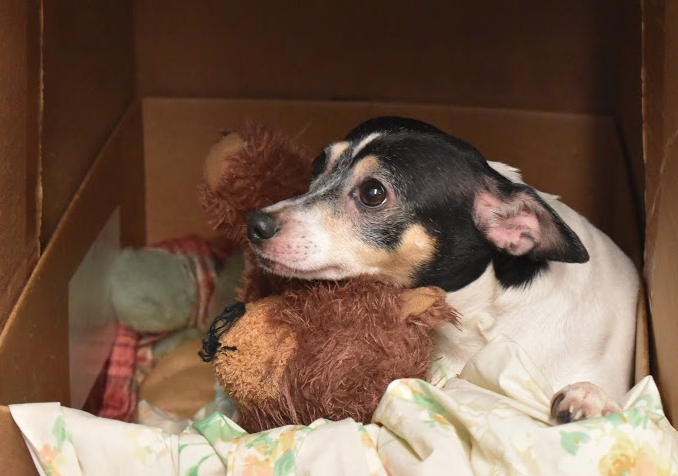A dog’s life
Olivia, Charelle Pennington’s rat terrier, rests in her box next to her caretaker’s desk in the main office.
As people rush in and out of the main office, Lincoln’s smallest therapist lies in her cardboard box tucked under a desk. With a teddy bear at her side, she stares with wide eyes at the comings and goings.
Olivia Grace Pennington is a rat terrier. A certified service animal, she not only brightens the days of students and staff, but also supports for students with special needs or anyone in need.
But this isn’t the first time the 13-year-old dog has come to her owner’s work. Coming to work with Ms. Charelle Pennington, principal Peyton Chapman’s secretary, began as a necessity, but evolved into a tradition.
“We used to live in Georgia and I worked all year,” she says. “In the summer, the house got really hot and because Olivia’s breed is a burrow dog, she would bury herself in blankets and overheat. So I started bringing her to school so that I could keep an eye on her.”
Now, with Principal Peyton Chapman’s permission and a service animal license, Olivia fills the gap after Lincoln’s former therapy dog, Caprese, retired last year.
Caprese, a black lab, came to work with secretary Jennifer Van Orsdel until Van Orsdel’s retirement last year. Caprese was nearly fully therapy trained, however, she could not complete one part of the training, so she failed the course, after which Van Orsdel adopted her.
Caprese calmed students, who could lay on top of or beside her, says secretary Stephanie Kinnison.
Olivia had to pass prerequisites to come to school as a licensed service dog.
“I took her to obedience classes, then at the end of the class, she got a certificate,” says Ms. Charelle.
While Olivia was licensed as a service dog, she quickly became a therapeutic support system for students and faculty alike. Students sit on the floor with her or pet her if they need emotional support, Ms. Charelle says, “I sometimes put her on their laps. It’s therapeutic.”
Senior Adrienne George visits Olivia when she can.
“When I’m feeling emotionally unstable or upset, knowing that there is a dog around, someone I don’t have to talk to, is really nice,” she says. George has a dog at home, and says Olivia is very “scratchable.”
There is science behind the use of therapy animals, common in hospitals and care facilities. Harvard professor Edward O. Wilson has suggested that because humans in the past relied on animals to alert them about threats, such as a bear nearby. Today, animals still allow people to feel safe and secure, allowing healing and change to take place.
Petting a dog releases oxytocin in people, like holding a newborn child or hugging someone does, George says. “It negates negative things school can give you, stress, low motivation, depression.”
Olivia seems to love her “job.” Each morning, she runs up the stairs and slides around the corner into the main hallway.
“Some students know when we get here and they wait for her to come in,” Ms. Charelle says. Olivia has become the school’s second or unofficial mascot in the halls and the office, she says.
Kinnison says she shares a special bond with Olivia. “I’m like her other mother,” she says. “With those big ears and little nose, you can’t help but love her. I’m basically in the box with her.”
Secretary Cynthia Roberts agrees. “Olivia gives unconditional love,” she says. “No matter what mood you’re in, when a cute dog comes up to greet you, you can’t deny that.”
Most of the time, Olivia stays in her box. She has never tried to run off or bark, according to office staff, but does enjoy the occasional snack.
“Her middle is round, and growing,” Kinnison adds as Ms. Charelle laughs.
Roberts says, “Olivia feels like Lincoln is her home, just like teachers and students feel like that way.”

